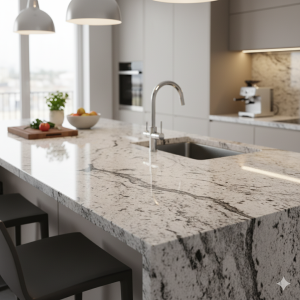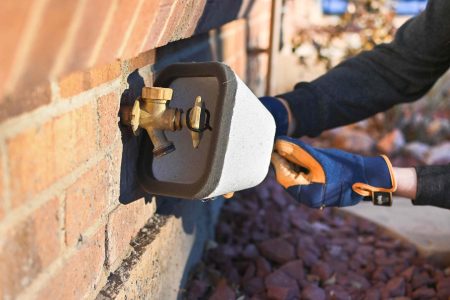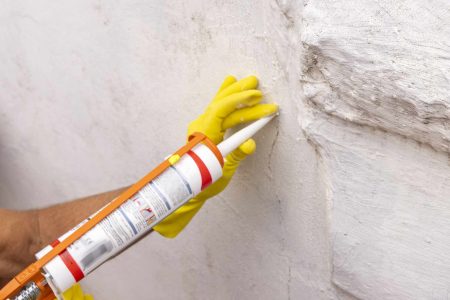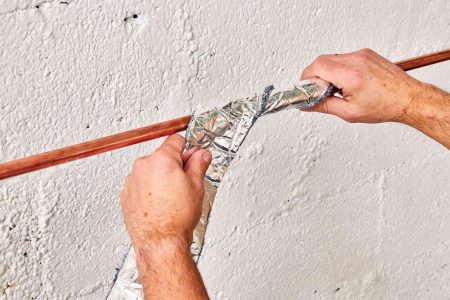Learning how to lay pavers is one of the quickest and easiest ways to install a patio and transform your outdoor space. Patio pavers can come in different materials such as stone, brick, or concrete. All paver types are long-lasting, durable, and low-maintenance. Unlike poured concrete slabs, laying an entire patio using pavers can be a DIY job.
Keep reading for a step-by-step guide on how to lay pavers, whether for a walkway, backyard patio, or around the pool.
What You’ll Need
Equipment / Tools
- Hammer
- Shovel
- Two-by-four
- Tamper
- Wheelbarrow
- Rake
- Broom
- Carpenter’s square
Materials
- Pavers
- Crushed rock base material
- 1 bag fine sand (10 pounds)
- Coarse bedding sand
- Garden hose
- Twine or thin rope
- Marking paint
- Wood stakes
- 2 metal pipes (3/4-inch)
Instructions
-
Plan the Patio Area
- Lay out the general area with a garden hose to get a basic sense of space. Refine this layout by hammering in wood stakes and creating a shape with thin rope or twine.
- Determine the quantity of pavers, base material, and sand to purchase on the general shape. Measure the length by the width to arrive at the total square footage. Add 10% to account for expected wastage.
-
Dig Out Turf and Soil
- In yards with grass, remove the turf until you reach the soil below.
- Place the bubble level on the two-by-four to check for slope. Ensure the patio slopes down about 1 inch (vertically) per 48 inches (horizontally). You may need to transfer the soil or add sand to create a slope.
- Make the pavers ground level by digging about 6 inches down to allow for 4 inches of base material, 1 inch of coarse sand bedding, and the pavers’ 1-inch thickness. The base material should be 3/4-inch minus construction gravel or crushed rock.
-
Smooth and Tamp Area
Use the shovel and the two-by-four to smooth out the area. Then, use the tamping tool to tamp down the soil.
-
Lay Base Material
Transfer the base material to the patio area. Spread the material with the shovel and rake. Screed the base material smooth with the two-by-four. Finish by tamping it firmly down.
-
Add Edging
Add the edge restraint of your choice to the base material. Some types of edging may need to be staked into the ground.
-
Lay Down Coarse Sand
- Lay about 1 inch of the coarse (not fine) bedding sand. Be sure to keep the height even across the area, as this is the last layer; its height will determine the final height of the patio.
- Keep the height consistent by pouring the sand over two parallel 3/4-inch pipes. Screed the two-by-four over the pipes then carefully remove the pipes.
-
Cut Pavers
Wearing hearing and breathing protection and safety glasses, cut the pavers with a masonry saw or an angle grinder fitted with a masonry disk. Because masonry pavers are difficult to cut, it’s often helpful to slightly adjust the patio’s size to accommodate full-size pavers all the way across.
-
Lay Pavers
- Lay the pavers on the coarse sand base. Keep the paver joints tight.
- Occasionally tamp the pavers by gently tapping them with a hammer. Soften the impact with a small piece of plywood or scrap two-by-four.
-
Add Sand to Joints
Toss a few handfuls of fine sand on the pavers and brush the sand into the joints. Sweep away any excess sand.
When to Call a Professional
Laying a patio is straightforward but handling the base materials and the pavers is strenuous, especially if you want to use large-format pavers (24 inches by 24 inches or greater).
It’s often worthwhile hiring a contractor to lay the patio, if only because the materials are so heavy and bulky to work with.
How Much Does a Paver Patio Cost?
Installing your own paver patio costs from $500 to $1,500, depending on the type of pavers you choose and whether you already own the tools or need to rent them.
As long as the materials are in place and nearby, you can lay about 100 square feet of patio pavers in a day.
You may need to rent equipment, which costs about $350. Plus, you can expect to pay about $5 per square foot for materials.
The average size patio project is about 280 square feet, and the national average for professional installation and materials is $3,800, with prices ranging from $2,400 to $7,000.
-
Can you lay pavers directly on dirt?
In most cases, you cannot lay pavers directly on dirt. To achieve a stable surface, the dirt base must first be compacted, and then a layer of aggregate and sand must be laid.
-
What do you put under pavers?
First, put a stabilizing base of 3/4-inch minus construction gravel or crushed rock. Put coarse sand on top of the base. After you have laid the pavers, sweep either fine sand or polymeric sand between the pavers.
-
Should I lay pavers on sand or gravel?
Pavers are best installed on top of a flexible medium such as gravel to move with the ground’s temperatures. Sand alone is not recommended because the pavers can move too much, plus, sand is already used to prep the ground when laying pavers. Pavers installed on a concrete surface will not be as malleable and may crack over time.
Read the full article here










